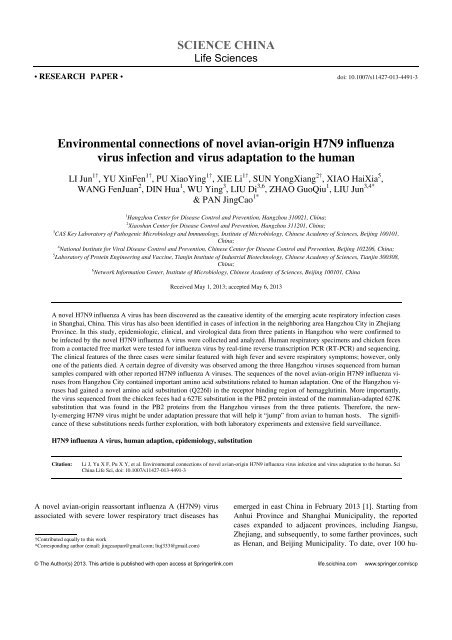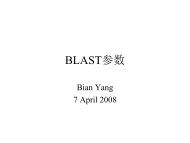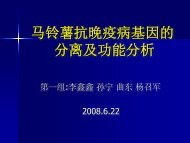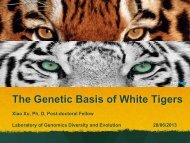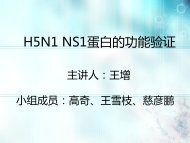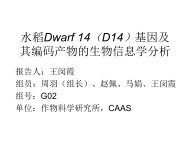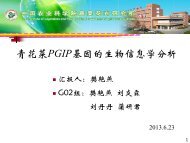Environmental connections of novel avian-origin H7N9 influenza ...
Environmental connections of novel avian-origin H7N9 influenza ...
Environmental connections of novel avian-origin H7N9 influenza ...
You also want an ePaper? Increase the reach of your titles
YUMPU automatically turns print PDFs into web optimized ePapers that Google loves.
Li J, et al. Sci China Life Sci June (2013) Vol.56 No.6 32 Results2.1 Epidemiological and clinical features <strong>of</strong> the cases inHangzhou City, Zhejiang ProvinceEpidemiological and clinical information were collectedfrom the patients’ medical records, as well as from interviewswith them and their relatives. Details <strong>of</strong> the investigationare recorded in Table S1. Patient 1 was a 38-year-oldman with a history <strong>of</strong> hepatitis B virus infection and thepositive hepatitis B surface antigen was detected. The manwas a cook who had visited a poultry market every otherday before the onset <strong>of</strong> his symptoms. He had high feverand cough at the onset <strong>of</strong> the illness. Patient 2 was a67-year-old man who had a history <strong>of</strong> hypertension andnasitis. One week before the onset <strong>of</strong> the symptoms, he hadvisited a free market and bought two live quails which werebutchered in the market. He cooked the quail himself andate some <strong>of</strong> it. No other poultry contact in the two weeksbefore the onset <strong>of</strong> the illness was reported by Patient 2.Patient 2 also had high fever, cough, and sputum productionat the onset <strong>of</strong> the illness. Patient 3 was a 79-year-old man.He had no known history <strong>of</strong> exposure to live birds duringthe two weeks before the onset <strong>of</strong> symptoms. This patienthad a cough and was found to have high fever on admission.The general clinical features <strong>of</strong> the three Hangzhou patientswith confirmed infections <strong>of</strong> the <strong>avian</strong> <strong>influenza</strong> A(<strong>H7N9</strong>) virus were similar to the three cases reported previouslyin Shanghai and in Anhui Province [1]. All threepatients presented with high fever, cough, shortness <strong>of</strong>breath, and a history <strong>of</strong> sputum production. In Patient 1, thesputum was bloodstained, which was not reported in thethree <strong>H7N9</strong> virus infected cases in the previous study [1].None <strong>of</strong> the patients had diarrhea, conjunctivitis, or rash.Physical examination <strong>of</strong> the chest in all three patients revealedrespiratory distress and crackles, and rapid breathingin Patients 1 and 3. The white cell counts were normal forthe three cases. The levels <strong>of</strong> creatine kinase and lactatedehydrogenase were increased in all three patients. Bilateralor unilateral ground-glass opacities and pleural effusionwere observed by chest radiography (Figure 1).Antibiotic therapy combined with glucocorticoids wasadministered to all three patients. Antiviral therapy and intravenousimmunoglobulin were given to Patients 2 and 3.Patient 1 was admitted to the intensive care unit and intubatedseven days after admission. Pneumonedema and acuterespiratory distress syndrome developed in this patient andhe died on day 21 after the onset <strong>of</strong> his illness. Patients 2and 3 were transferred to negative pressure wards after thelaboratorial confirmation <strong>of</strong> the <strong>H7N9</strong> infection and theirvital signs gradually improved.2.2 Causative pathogen <strong>of</strong> the infections and the environmentalconnectionThe RT-PCR and sequencing results for the amplified PCRproducts confirmed that <strong>H7N9</strong> <strong>influenza</strong> virus was thecausative agent <strong>of</strong> the illness and death for Patient 1. ForPatients 2 and 3, the infection <strong>of</strong> <strong>influenza</strong> A (<strong>H7N9</strong>) viruswas confirmed by real-time RT-PCR. The RT-PCR andsequence confirmed-viruses identified in Hangzhou fromPatients 1, 2 and 3 were named A/Hangzhou/1/2013 (<strong>H7N9</strong>)(Hangzhou/1), A/Hangzhou/2/2013(<strong>H7N9</strong>) (Hangzhou/2)and A/Hangzhou/3/2013(<strong>H7N9</strong>) (Hangzhou/3), respectively.<strong>Environmental</strong> specimens related to Patient 2 were alsotested. Poultry cage swabs and feces from the free marketthat Patient 2 visited one week before the onset <strong>of</strong> thesymptoms were positive for the <strong>novel</strong> <strong>avian</strong> <strong>influenza</strong> A(<strong>H7N9</strong>) virus. We named this environmental virus A/environment/Hangzhou/34/2013(<strong>H7N9</strong>)(Env/Hangzhou).2.3 Sequence diversity <strong>of</strong> <strong>H7N9</strong> Hangzhou virusesA phylogenic tree was constructed after aligning multipleH7 sequences from the Hangzhou viruses and from otherFigure 1 Chest radiographs. A, Computed tomography scan <strong>of</strong> the chest <strong>of</strong> Patient 1 was obtained on day 6 after the onset <strong>of</strong> the illness. Consolidation <strong>of</strong>inferior lobe <strong>of</strong> right lung and bilateral patches <strong>of</strong> higher density shadow can be seen. B, Chest radiographs <strong>of</strong> Patient 1 on day 11. Bilateral ground-glassopacity and consolidation can be seen.
Li J, et al. Sci China Life Sci June (2013) Vol.56 No.6 5Figure 2 Phylogenetic tree based on HA sequences. The tree was generated using the maximum likelihood method with 1000 bootstrap replicates. Thevirus strains from this study are in red; the publicly available human <strong>H7N9</strong> viruses are in green, and the other remaining <strong>H7N9</strong> viruses are in cyan. Shanghai/1,A/Shanghai/1/2013; Chicken/Zhejiang, A/Chicken/Zhejiang/DTID-ZJU01/2013; Env/Nanjing, A/Environment/Nanjing/2913/2013; Nanjing/1, A/Nanjing/1/2013; Chicken/Shanghai, A/Chicken/Shanghai/S1053/2013; Env/Shanghai, A/environment/Shanghai/S1088/2013; Shanghai/2, A/Shanghai/2/2013; Pigeon/Shanghai, A/Pigeon/Shanghai/S1069/2013; Zhejiang/DTID-ZJU01, A/Zhejiang/DTID-ZJU01/2013; Anhui/1, A/Anhui/1/2013.
6 Li J, et al. Sci China Life Sci June (2013) Vol.56 No.6Figure 3 Chromatogram <strong>of</strong> the HA sequences flanking the amino acids atposition 226. The dashed boxes show the nonsynonymous substitutions.The 226I substitution in the HA <strong>of</strong> Hangzhou/1 is compared with the 226Lin the other three viruses.in the newly-emerging <strong>H7N9</strong> virus.3 DiscussionWe described three infected cases in Hangzhou City andidentified the <strong>novel</strong> reassortant <strong>influenza</strong> A (<strong>H7N9</strong>) virusesin the respiratory specimens from these patients, as well asfrom environmental samples. Hangzhou City is close toShanghai Municipality, where the first <strong>influenza</strong> A (<strong>H7N9</strong>)virus infections were reported [1]. Although later than thecases in Shanghai Municipality, the onset <strong>of</strong> the illness <strong>of</strong>two <strong>of</strong> the patients described here was reported around thesame time as the illness <strong>of</strong> the patient in Anhui Province.Two <strong>of</strong> the three patients had a history <strong>of</strong> direct contact withlive poultry or with local free markets. A closely related<strong>H7N9</strong> virus was identified in the contacted environment <strong>of</strong>Patient 2. These data may provide direct evidence for thelinking, or even transmission, <strong>of</strong> the <strong>avian</strong> <strong>H7N9</strong> viruses tohumans in these adjacent provinces <strong>of</strong> east China.Although the clinical characteristics <strong>of</strong> the three casesreported here are very similar to the early cases reportedpreviously in Anhui and Shanghai, namely high fever andsevere respiratory symptoms, the genetic diversity <strong>of</strong> thegenomes <strong>of</strong> the new Hangzhou <strong>H7N9</strong> viruses was determined.The H7 phylogenetic trees placed the Hangzhou/1,Hangzhou/2 and Hangzhou/3 viruses on separate branches.Within the HA, NA and PB2 sequences from all the publiclyavailable <strong>H7N9</strong> viruses, we identified 36 sites with atleast one amino acid mutation (Table 2). These data mayindicate the independent and rapid evolution <strong>of</strong> the virusesin the natural reservoir and their independent introduction tohuman. However, based on the currently available <strong>H7N9</strong>virus sequences, we found a series <strong>of</strong> other substitutions themajority <strong>of</strong> which were synonymous mutations (Table S2).The effects <strong>of</strong> these substitutions on the fitness <strong>of</strong> the virus-Figure 4 Map <strong>of</strong> China showing the substitutions in the host-signatures from the different virus sequences. The provinces and municipal cities with reported<strong>H7N9</strong> cases are in brown. The features <strong>of</strong> each <strong>of</strong> the sites are shown as follows: Province (number <strong>of</strong> human cases+number <strong>of</strong> environment/poultrycases), Gene (amino acid position): Residue (human); Residue (environment/poultry). Residues with <strong>avian</strong>-signatures are in purple; residues with mammalsignaturesare in yellow. The 226I in the HA from A/Hangzhou/1/2013 is highlighted in red.
Li J, et al. Sci China Life Sci June (2013) Vol.56 No.6 7Table 2 Variable amino acid residues in the HA, NA and PB2 proteins <strong>of</strong> <strong>H7N9</strong> viruses a)Protein b) Position Hangzhou/1 Hangzhou/2 Hangzhou/3 Env/HangzhouZhejiang/DTID- Chicken/ZJU01 ZhejiangShanghai/1 Shanghai/2 Anhui/1PB2 195 D E D D D D D D D197 K R K K K K K K K224 S T T T T T T T T292 V V V V V V V I V395 A A A A S A S A A461 I I I I I I V I I559 N T N N N N T N N627 c) K K K E E E K K K701 c) D D D D N D D D D740 D D A D D D D D DHA 42 V V V V V G V V V65 R R M R R K R R R72 C C C C C G C C C74 L L L L L P L L L75 L L L L L R L L L96 I I I I I M I I I146 A A A A A A S A A173 M I M M M M M M M183 S S S S S S N S S195 V V V V V V G V V230 P P P P P P T P P235 d) I L L L L Q Q L L285 N N N N N N D N N292 H H H H H H Y H H410 N N N N N N T N N541 V V V V V V A V VNA 26 I I I I I I M I40 G S G G G S G G294 e) R R R R R R K R R305 I I V I I I I I I345 N N I N N N N N N428 L L L L L V L L L439 W W W W L W W W W441 T T T T T A T T T442 S S S S G G S S S443 N N N N D N N N Na) The full names <strong>of</strong> the viruses are listed in the legend <strong>of</strong> Figure 2. b) Numbering <strong>of</strong> the protein sequences begins with the first ATG start codon (methionine).c) The E627K or D701N substitutions in the PB2 protein are critical for the adaptation <strong>of</strong> <strong>avian</strong> <strong>influenza</strong> A viruses to their mammalian hosts. Importantresidues discussed in the text are shaded gray. d) The Q235L mutation (Q226L in the H3 numbering system) increases the binding affinity <strong>of</strong> HA tothe human receptor. e) The R294K mutation (R292K in the N2 numbering system) in the NA protein confers resistance to oseltamivir.es have not been determined. This result may indicate thenecessity for an extensive surveillance to investigate theaccumulated effects <strong>of</strong> these virus substitutions on thepathogenesis <strong>of</strong> human.The pathogenesis <strong>of</strong> the <strong>novel</strong> <strong>avian</strong>-<strong>origin</strong> <strong>H7N9</strong> virusin humans remains unknown; however, a series <strong>of</strong> substitutionswere found in Hangzhou <strong>H7N9</strong> viruses which hadbeen determined previously to be related with infection andsevere diseases in animal models [12]. For example, thesubstitution at position 226 <strong>of</strong> the HA protein has been determinedas pivotal residue in the binding <strong>of</strong> <strong>avian</strong>- or human-typereceptor and, it has been suggested, that the presence<strong>of</strong> residue 226L might increase the airborne transmission<strong>of</strong> the virus [4,13]. The Q226L substitution in the HAprotein <strong>of</strong> H5 laboratory-mutated viruses was shown tocause the viruses to bind strongly to α-2,6 human-like receptors[5,14]. However, we observed a Q226I substitutionin the HA sequence from Hangzhou/1. Isoleucine and leucineare both hydrophobic residues which may imply thatthe Q226I mutation plays a similar major role in the α-2,6receptor binding and human adaption <strong>of</strong> some <strong>of</strong> the new<strong>H7N9</strong> viruses. Some <strong>of</strong> the sequences <strong>of</strong> the H3 subtype <strong>of</strong>human infected <strong>influenza</strong> viruses that we obtained from theInfluenza Virus Resource database [9] also contained theQ226I mutation. However, this is the first report <strong>of</strong> theQ226I substitution at this site for the H7 subtype (Figure 4),which may indicate a <strong>novel</strong> host adaption feature <strong>of</strong> the H7virus [12]. The receptor binding properties <strong>of</strong> HAs thatcontain the Q226I substitution need direct experimentalinvestigation.Previous studies indicated that several substitutions inPB2 sequences were associated with efficient virus replicationwhich contributed to the high pathogenicity <strong>of</strong> H5N1viruses in mice [68]. Two amino acid positions in the PB2
8 Li J, et al. Sci China Life Sci June (2013) Vol.56 No.6protein affect the growth <strong>of</strong> <strong>influenza</strong> viruses in mammaliancells [68]; namely, positions 627 (PB2-627) and 701(PB2-701). In most human <strong>influenza</strong> viruses the residue atposition 627 is lysine (PB2-627K) and in most <strong>avian</strong> virusesit is glutamic acid (PB2-627E). Thus, 627K in PB2 is amammal-signature amino acid. The alignments <strong>of</strong> the publiclyavailable <strong>H7N9</strong> PB2 sequences revealed that the PB2sequence from a human sample <strong>of</strong> the Zhejiang/DTID-JU01 virus had a 627E substitution (Figure 4). TheZhejiang/DTID-ZJU01 virus also had a special D701N mutationwhich was confirmed previously to be important forthe high virulence <strong>of</strong> this virus in animal models [8,15].Together, these data for the different important amino acidsubstitutions in the proteins <strong>of</strong> <strong>novel</strong> <strong>H7N9</strong> viruses indicatea divergent adaption mode for the <strong>influenza</strong> A virus in human[16,17].The genotypic diversities <strong>of</strong> the <strong>novel</strong> <strong>H7N9</strong> viruses thatwe sequenced from the patients and the contact poultrymarket in Hangzhou, Zhejiang Province implied that these<strong>novel</strong> viruses exhibited rapid evolution. The results <strong>of</strong> thisstudy may shed light on the understanding <strong>of</strong> the source andmode <strong>of</strong> transmission <strong>of</strong> these infections, and will provide areference for the considerate selection <strong>of</strong> candidate vaccinestrains.This work was supported by the Hangzhou Key Medicine Discipline Fundfor Public Health Laboratory sponsored by the Hangzhou government,National Basic Research Program <strong>of</strong> China (2010CB530303, 2011-CB504703), and an intramural special grant for <strong>influenza</strong> virus researchfrom Chinese Academy <strong>of</strong> Sciences (KSZD-EW-Z-002). We thank Dr. GaoGeorge F. for his advice on the design <strong>of</strong> this study and for his criticalreview for the manuscript. We also thank the staff <strong>of</strong> the MicrobiologyLaboratory <strong>of</strong> Hangzhou Center for Disease Control and Prevention fortheir excellent technology support, and Dr. Zhu Dan for his interpretation<strong>of</strong> the patients’ radiographs. The authors declare no financial or commercialconflict <strong>of</strong> interest.1 Gao R, Cao B, Hu Y, et al. Human infection with a <strong>novel</strong><strong>avian</strong>-<strong>origin</strong> <strong>influenza</strong> A (<strong>H7N9</strong>) virus. N Engl J Med, 2013, doi:10.1056/NEJMoa13044592 Liu D, Shi W, Shi Y, et al. Origin and diversity <strong>of</strong> <strong>novel</strong> <strong>H7N9</strong> <strong>avian</strong><strong>influenza</strong> viruses causing human infection. Lancet, 2013, doi:10.1016/S0140-6736(13)60938-13 Kageyama T, Fujisaki S, Takashita E, et al. Genetic analysis <strong>of</strong> <strong>novel</strong><strong>avian</strong> A(<strong>H7N9</strong>) <strong>influenza</strong> viruses isolated from patients in China,February to April 2013. Eurosurveillance, 2013, 18: pii=204534 Herfst S, Schrauwen E J, Linster M, et al. Airborne transmission <strong>of</strong><strong>influenza</strong> A/H5N1 virus between ferrets. Science, 2012, 336: 1534–15415 Imai M, Watanabe T, Hatta M, et al. Experimental adaptation <strong>of</strong> an<strong>influenza</strong> H5 HA confers respiratory droplet transmission to areassortant H5 HA/H1N1 virus in ferrets. Nature, 2012, 486: 420–4286 Li Z, Chen H, Jiao P, et al. Molecular basis <strong>of</strong> replication <strong>of</strong> duckH5N1 <strong>influenza</strong> viruses in a mammalian mouse model. J Virol, 2005,79: 12058–120647 Shinya K, Hamm S, Hatta M, et al. PB2 amino acid at position 627affects replicative efficiency, but not cell tropism, <strong>of</strong> Hong KongH5N1 <strong>influenza</strong> A viruses in mice. Virology, 2004, 320: 258–2668 Steel J, Lowen A C, Mubareka S, et al. Transmission <strong>of</strong> <strong>influenza</strong>virus in a mammalian host is increased by PB2 amino acids 627K or627E/701N. PLoS Pathog, 2009, 5: e10002529 Bao Y, Bolotov P, Dernovoy D, et al. The <strong>influenza</strong> virus resource atthe national center for biotechnology information. J Virol, 2008, 82:596–60110 Rodriguez F, Oliver J L, Marin A, et al. The general stochastic model<strong>of</strong> nucleotide substitution. J Theor Biol, 1990, 142: 485–50111 Stamatakis A. RAxML-Vi-HPC: maximum likelihood-based phylogeneticanalyses with thousands <strong>of</strong> taxa and mixed models. Bioinformatics,2006, 22: 2688–269012 Jonges M, Meijer A, Fouchier R A, et al. Guiding outbreakmanagement by the use <strong>of</strong> <strong>influenza</strong> A(H7Nx) virus sequenceanalysis. Eurosurveillance, 2013, 18: pii=2046013 Russell C A, Fonville J M, Brown A E, et al. The potential forrespiratory droplet-transmissible A/H5N1 <strong>influenza</strong> virus to evolve ina mammalian host. Science, 2012, 336: 1541–154714 Fouchier R A, Garcia-Sastre A, Kawaoka Y, et al. Transmissionstudies resume for <strong>avian</strong> flu. Science, 2013, 339: 520–52115 Chen Y, Liang W, Yang S, et al. Human infections with the emerging<strong>avian</strong> <strong>influenza</strong> A <strong>H7N9</strong> virus from wet market poultry: clinicalanalysis and characterisation <strong>of</strong> viral genome. Lancet, 2013, doi:10.1016/S0140-6736(13)60903-416 Quynh M L, Sakai-Tagawa Y, Ozawa M, et al. Selection <strong>of</strong> H5N1<strong>influenza</strong> virus PB2 during replication in humans. J Virol, 2009, 83:5278–528117 Li Q, Zhou L, Zhou M, et al. Preliminary report: epidemiology <strong>of</strong> the<strong>avian</strong> <strong>influenza</strong> A (<strong>H7N9</strong>) outbreak in China. N Engl J Med, 2013,doi: 10.1056/NEJMoa1304617Open Access This article is distributed under the terms <strong>of</strong> the Creative Commons Attribution License which permits any use, distribution, and reproductionin any medium, provided the <strong>origin</strong>al author(s) and source are credited.Supporting InformationTable S1 Clinical features <strong>of</strong> the patients on admissionTable S2Molecular analysis <strong>of</strong> amino acid difference in the viral proteins between Hangzhou/1 isolate and other three reported <strong>H7N9</strong> virusesThe supporting information is available online at life.scichina.com and www.springerlink.com. The supporting materialsare published as submitted, without typesetting or editing. The responsibility for scientific accuracy and content remains entirelywith the authors.


